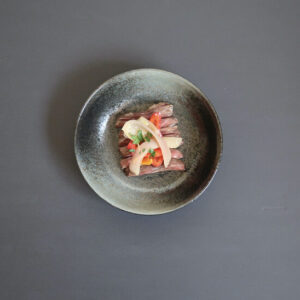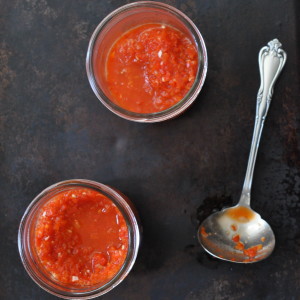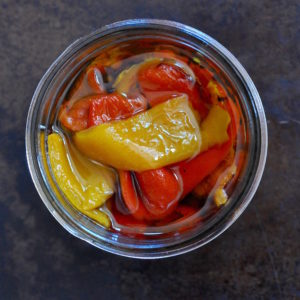Peppers and Onions
Constant readers may find this recipe similar to a post from last September.
While the recipes are comparable, there is no point in posting the same recipe twice. This only irritates you, my readers, while using up valuable time and energy better spent on fresh material.
With that, on with the show.
–
Granted, Oysters and Pearls this is not. But when did you last saute peppers and onion together until they were a nice melty tangle?
(We’re not going to say “jammy” here, because it’s overused. Melty, okay?)
I thought so.

Granted, peppers are not in season, but the way things are going in the United States, they’re about to get more expensive than Thomas Keller’s infamous dish. So enjoy those imported babies while you can.
And if you need a new refrigerator to store said peppers in, the time to buy is now.
—
Peppers and onions began life as an accompaniment to faux-fajitias. When I found myself more interested in the pepper/onion mixture than the steak, I bought more peppers and onions, sauteed them, and kept them in the fridge the way another person might keep a favorite brand of mustard.

Most of the time, peppers and onions find their way into sandwiches. Yours truly is happy to put almost any leftover between two pieces of decent bread and call it lunch. Adding a few spoonfuls of sauteed peppers and onions only improved matters.

The plate is compostable. Don’t freak out.
Peppers and onions are like zucchini: it is difficult to think of foods they do not get along with. I’ve made sandwiches of pepper, onion, ham, and lettuce, pepper, onion, and leftover chicken, pepper, onion, and roasted cherry tomatoes, peppers, onion, and the very last bits of roast beef. All were good.

These lunches are invariably consumed before the computer, to the detriment of many a keyboard. (Not pictured.)

—
My husband does not share my fondness for either peppers or onions, making them a solo indulgence. This means I don’t prepare much at any given time: one large red pepper and perhaps half of a large onion is it. Sometimes I add a minced garlic clove, sometimes not.

Peppers and onions require low, slow cooking. Fried onions are not what we’re after here. I cook the vegetables in olive oil, but canola or grapeseed oil will work.

Inexpensive white wine or vegetable broth keeps the mixture from drying out.

Peppers and onions have many applications beyond the sandwich. Add them to pasta sauces, use them to top pizzas, stir them into rice or polenta, or serve them alongside pork, poultry, fish, beef, or tofu. Peppers and onions are especially delicious folded into a tortilla with chicken, sour cream, hot sauce, lettuce, and avocado. Have lots of napkins handy.

Peppers and Onions
Yield: as much as you like
Prep Time: minimal, 30-45 minutes cooking time
About two tablespoons olive or canola oil, for the pan
generous 1/4 cup/60 ml white wine or mild vegetable broth
1 large red or yellow bell pepper
1/2 large or 1 medium yellow onion
1 garlic clove (optional)
salt and pepper
Wash, core, and seed the pepper. Cut pepper into lengthwise slices.
Peel and slice the onion. If the onion is large, use half of it, or an amount roughly equal to the pepper.
Crush and mince the garlic clove, if using.
Place a saute pan on the stove and add the olive oil. Heat gently. Add garlic clove, if using. Cook for a minute or so. You want it to become translucent rather than brown. If garlic is browning, turn the heat down.
Add the wine or broth, then tip in the vegetables. Adjust heat so liquid simmers gently–you don’t want a galloping boil.
Cover pan and cook vegetables, 10-15 minutes, stirring occasionally. You should not need to add more liquid, but if the pan goes dry, add a bit more wine, broth, or water.
After 15 minutes, season vegetables with a scant teaspoon salt and pepper. I added a little sumac, because I adore its lemony flavor, but don’t feel obligated.
Cover the pan again, and cook pepper and onion another 15 minutes, until vegetables are softened. At this point it’s a question of personal taste: you can continue cooking longer, or stop. Taste and decide.
Peppers and onions have numerous applications. Stir them into pasta, polenta, or rice. Drape them atop pizza. Do as I do and add them to sandwiches. Nestle them alongside pork, poultry, fish, beef, or tofu. Fold them into a tortilla with chicken, sour cream, hot sauce, lettuce, and avocado. Eat them with black beans.
Peppers and onions keep, refrigerated in a lidded container, for about six days. Freezing is not recommended.
Note: I do not suggest using green peppers due to their harsher flavor profile. If you are a green pepper fan, go for it.





